#the blythes are quoted
Text
“I had a hard time to get her, I can tell you that.”
— Gilbert Blythe, of wife Anne, to their son Jem, the Blythes are Quoted by Lucy Maud Montgomery
23 notes
·
View notes
Text
Late November came, and the cold kiss of the snowflakes.
L.M. Montgomery, The Blythes Are Quoted
#it's so cold outside!#i've had two cups of hot chocolate today and i still can't get warm#i'm going out for friendsgiving tonight and when i tell you i do not want to step out into this frigid wind!#it's a good thing i only do my black friday shopping online#l.m. montgomery#anne of green gables#the blythes are quoted#literature
347 notes
·
View notes
Text
Hey, I loved Anne. What LM Montgomery book should I read next?
It's no secret that Anne of Green Gables is far and away LM Montgomery's most famous book. It's the classic; the book you think of when you heard the name LM Montgomery. It's her stereotypical Barbie, if you will. Even if someone has read a book other than Green Gables, it's usually the subsequent books in Anne's series (which is absolutely the right choice). Consequently, diving into the rest of LM Montgomery's work can be overwhelming. There are quite a few series of young women coming into their own, some of which are on Anne's level, and some of which aren't. Even beyond the Emilys and the Pats, there are also books that don't quite fit the mold of Singular Young Heroine Faces Life - The Story Girl features a much broader cast and scope despite its featured heroine Sara.
Because I love LM Montgomery and will talk about her at any point, I wanted to write up a brief summary of her series other than Anne and just try to express their vibes for someone who might be curious as to where to go next. Someone who loves Anne might hate Pat (who, me?), and someone who was tepid on Anne might love Emily. Of course, LM Montgomery is LM Montgomery, so her stories are usually solid regardless - but hey, sometimes you want an eerily witchy story, and sometimes you want a warm and cozy one. Disclaimer that I'm not including LMM's entire canon of work here (ie poems and short stories).
So, with that, let's get started.
Emily of New Moon (3 books)
Did you read the Anne series and think it was a little...Pollyanna-ish? Perhaps you even whipped out that dreaded word, "saccharine." Or maybe you loved it, but you're curious as to what a darker LM Montgomery would be. Say no more. Emily is a gothic, witchy series, with dark undertones of resentment and depression. It's also blatantly autobiographical - like, really, autobiographical - like, LM Montgomery straight up copied passages from her diary into the book autobiographical! The storyline overall does differ from LM Montgomery's life, but Emily dreams of being a writer much like Anne while being much sharper than Anne. It's also more eerie - there are hauntings and second sight events sprinkled throughout the series, along with the aforementioned gothic undertones overall. Yet for all this, it still solidly retains LM Montgomery's flair for cheeky stories and dreamy heroines and embarrassing moments and gentle life lessons. It's a still slice of life; it's just a slice of a darker one.
The Blue Castle (1 book)
Imagine the most generic, trope filled, basic romantic storyline - shy girl gets makeover esque - and then pump it full of LM Montgomery's genius, add in a few screwball twists for the fun of it, and create the most cathartic book ever written. Have a family you can't stand that you just want to tell off sometimes? This book is for you. Want to live that cottagecore life with your soulmate? This book is for you. Daydream of a better life? This book is for you. Love a book with plot twists that you never see coming? Oh boy, this book is for you. This is one of two novels that LM Montgomery writes for adults, and it shows in the material handled. We have unwed mothers, hints at sexual awakenings, sexual harassment, and overall LM Montgomery from an older perspective. The heroine here is 29 at the beginning of the book, an unusual age for an LM Montgomery story to begin. Also, Barney Snaith supremacy. If you loved Gilbert, you'll love Barney too (dare I say perhaps even more). The blue castle is one of LMM's few books where the love interest is one of the main characters too instead of a side plot. It's also a standalone novel, which makes it more accessible in terms of storyline.
Jane of Lantern Hill (1 book)
Lo and behold, another standalone novel! And in my opinion, LM Montgomery's best. Notable for having an actual lion in it (that was based on true events!), Jane of Lantern Hill is a cheerful story of a little girl coming into her own. More practical than the other heroines (Jane is the same girl who dreams of having a potato ricer), Jane stands in a very cozy story that has a parent trap type plot (no trapping involved, but long estranged parents do reunite). It also has one of LM Montgomery's best villains, Jane's Grandmother, who is a chilling example of emotional abuse without any buffoonery or comedy to soften it. If you're looking for a comfort book to read with a cup of tea on a rainy day, this is it. It's not really a romance - romance is the tiniest of plot threads in this - it's a father daughter story bestowed with the typical LM Montgomery magic.
The Story Girl (2 books)
This was LM Montgomery's personal favorite, and it's delightful. It features more of a cast of characters than a main heroine situation, although the main heroine is there, so it's a bit unique in that regard. It's also in first person, and (gasp) that person is a boy. That sets it very apart from her other novels! The Story Girl, as hinted by the name, is very story heavy; it's LM Montgomery telling the story of a crowd of children growing up on PEI, yes, but it's also her delving into fairy tales and urban legends (PEI style) and local history. If you really liked the Hester Gray chapters from Anne, you'll probably like this quite a bit; the novel takes the same sort of delving approach but with a broader focus (we hear stories of princes and stories of neighbors). It also, unlike her other novels, is a memory. Bev, our narrator, is a grown man recounting his childhood - something acknowledged in the first book and emphasized in the second. Without any romance in it (besides of course, in the stories) and with a broader character focus (Sara is our heroine, but she's one of a group, and not the narrator), this novel veers away from the typical tightly focused LM Montgomery coming of age formula. It's group shenanigans rather than a personal journey.
Pat of Silver Bush (2 books)
Ah, Pat. Oh, Pat. I suggest reading these after you read the rest of LM Montgomery's work. Pat is interesting because the narrative tells us one thing, and Pat's actions tell us another. It's a book to read and analyze as an LM Montgomery novel, in my opinion, rather than a book to read to enjoy. It's good - it features one of my favorite LM Montgomery heroes in Jingle - but Pat is frenetic and depressed, to the point the novel's attempted cheerfulness skitters into mania. It's an LM Montgomery that doesn't stick the landing, which makes where it does land all the more interesting. LM Montgomery loves characterizing houses - in this the house is a character to the point where it's almost ominous. It's LM Montgomery but with an unintentional offkey chord that makes for unpleasant reading but fascinating examination.
Rilla of Ingleside (1 book, from Anne's series)
Including this because she's technically a different heroine than Anne - this is a war novel. It's LM Montgomery, but it's also a war novel. It's Anne, and it's a heartbroken Anne. It's also LM Montgomery's magnum opus (at least in my humble opinion). It's gritty in a way all of LM Montgomery's books aren't; it's an account of WWI from a unique perspective of a girl on PEI (and account is the word for it - there's discussion of specific battles and events date by date). The theme of WWI pops up frequently in LM Montgomery's later books, all of them building up to this book - read it and you'll appreciate the beginning Anne books all the more, because you know where they end.
The Blythes are Quoted (1 book, from Anne's series)
Do you really, really want more Anne? You've read all the books multiple times, hunted down the short stories where she's referenced, and you still want more? You're in luck, because this book was published in 2009, over half a century after LM Montgomery died. It's full of short stories that offer glimpses of the Blythes growing up, but it also has stories that take place after WWI, and it has interludes with the Blythe family written in a script format (think reading a play). It's cutting - these are not happy interludes - but it adds a rich dimension to Anne's story, and gives another glimpse at what happened to the characters.
Other
There are a scattering of other novels - Magic for Marigold, A Tangled Web - along with hundreds of short stories. I'd save these for last. These vary wildly in quality and so you're as likely to hit a dud as a diamond in the rough. There are a few incredible short stories that are LM Montgomery at her best, but there's also quite a lot of odd ones that can get downright uncomfortable. Magic for Marigold and A Tangled Web hit the same issues, growing uncomfortably sexist/racist at points. If you are determined to read all of LM Montgomery's work (hey, I've been there), these are solid stories but there are better ones.
#lm montgomery#the blue castle#emily of new moon#aogg#the story girl#the blythes are quoted#pat of silver bush
137 notes
·
View notes
Text
Am I the only one who actually liked The Blythes Are Quoted for its stories? As in, not the vignettes about the Blythes and the poems (I skipped those as I don't do poetry). Some Fools And A Saint and Here Comes The Bride are my favourite stories in this collection. It's just that if I see people mention this book, it's usually to do with Anne and Gilbert and their kids/grandkids. Tbh I'm not that bothered about them, I hope they were very happy and all that, but there's already plenty of Anne and Gilbert content.
27 notes
·
View notes
Text
1 note
·
View note
Text


Blythe Baird // Dave Eggers
#blythe baird#dave eggers#quotes#book quotes#classic literature#poetry#deep quotes#dark academia#chaotic academia#light academia
36K notes
·
View notes
Text
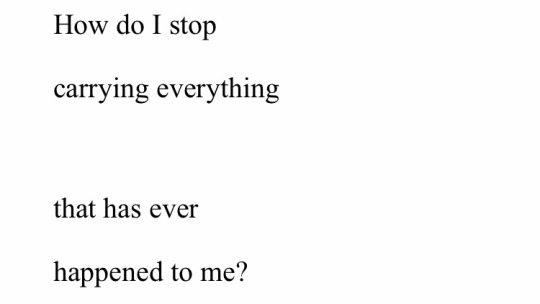
Blythe Baird, from If My Body Could Speak; “Concerns from a hot-boxed jeep”
[Text ID: “How do I stop / carrying everything / that had ever / happened to me?”]
#tw: trauma#blythe baird#girlhood#womanhood#excerpts#writings#literature#poetry#fragments#selections#words#quotes#typography#poetry collection
80K notes
·
View notes
Text

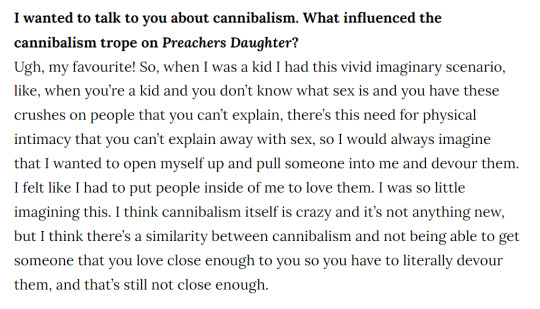


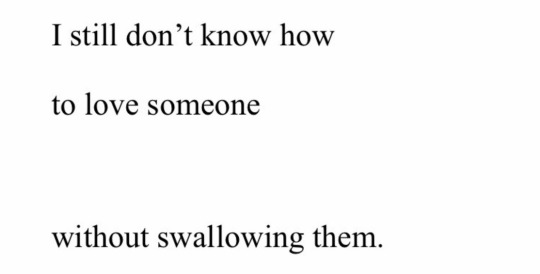
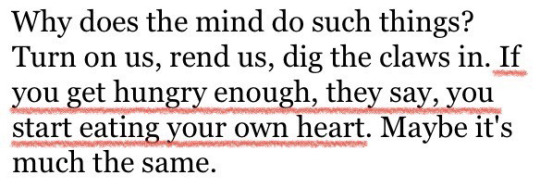
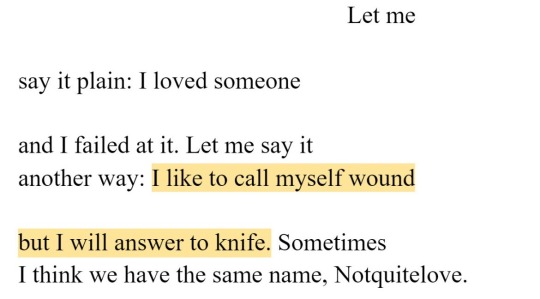

KILL ME IF IT'S WORTH IT; ON FLESH.
silas denver melvin // ethel cain // george bataille // blythe baird // margaret atwood // nicole homer // emily palermo.
#sorry 2 silas denver melvin for having to endure all the posts where he's mentioned </3#on flesh#web weaving#silas denver melvin#ethel cain#george bataille#blythe baird#margaret atwood#nicole homer#emily palermo#writing#poetry#webweaving#quotes
9K notes
·
View notes
Text
Lucy gray: Yeah I'm really into true crime podcasts lately.
Coriolanus, trying to flirt: You know I've been the primary suspect in quite a few murder cases.
#thg incorrect quotes#the ballad of songbirds and snakes#the hunger games#hunger games#thg#district 12#The capitol#lucy gray baird#coriolanus snow#Silly little snow#rachel zegler#Tom blyth#thg prequel#Covey
2K notes
·
View notes
Text
I’ll admit: I blamed her
for teaching me how
to be cruel to my body
because she let me
watch her set fire
to her own.
— Blythe Baird, from "What a Body Inherits," Sweet, Young, & Worried
2K notes
·
View notes
Text
✨Anne Blythe’s (Anne Shirley-Blythe’s namesake granddaughter) father is not Jem. It’s Shirley. It’s totally Shirley, you guys. It’s gotta be.✨
And like, Ieading right off by saying of course there’s no definitive answer to be had here, since Maud obviously isn’t available to confirm or refute any hypothesises, but I do big persist in suggesting that a very rational case can be presented for Shirley... one that at least outweighs what I now see as the generally baseless widely accepted assumption that Anne is Jem’s daughter. Keep in mind, I’m in no way trying to dog on this. The assumption is ready and easy to make, and I’d accepted fully this theory too, until about a week agooo.
ABOUT A WEEK AGO, I was poring over various Wikipedia entries for the Anne book series, and inevitably also ended up looking through the edit history of those pages. While sorting through the edit history (super extensive and interesting, by the way), the username ‘blefebvre’ popped into the archive, contributing a ton of information to the Anne pages overall, around 2008 and 2009 particularly. And literally, who else could this user be besides THE Benjamin Lefebvre? Brilliant Maud scholar and essayist, inexhaustible editor and publisher of ‘the Blythes are Quoted’? Welllll, one of these edits, a written family tree of Anne and Gilbert’s grandchildren, mentioned Anne Blythe... and pointedly noted that she was either the daughter of Jem or Shirley.
Reading that? Already a huge jump-scare surprise to me. This immediately challenged what I thought I knew about the third generation of Blythes. I sat straight up in bed, brain doing a nosedive, like wait wait wait wait wait… hold on, what? We don’t know for sure? We don’t know for sure?
Guys. We don’t know for sure.
Whichhhhh sent me on an immediate hunt to gather up what we do know for sure. The facts we do have. And it wasn’t a huge task, either… there’s really not a lot to collect.
But here it is:
In ‘the Blythes are Quoted’, Anne Blythe is mentioned in only one story, titled “The Road to Yesterday” (not to be confused with the TBAQ abridged predecessor book of the same title 😅).
All we really have of her is her name, and a couple of superficial second-hand anecdotes from a guy named Jerry (who is impersonating a fellow named Dick, but more on this a little later).
Her paternity is unconfirmed, but because her surname is Blythe (not Ford or Meredith), we can logically eliminate the possibility of her belonging to Nan, Di, or Rilla. Walter was, of course, lost in France. This leaves Jem and Shirley.
Tiny details about Anne.
As a matter of housekeeping, let me try to get the jump on any potential counter-arguments, and clear the air.
The only reason I’ve seen Jem credited with Anne is because…
1. Jem was married.
That’s the entire basis.
And I’ll grant you that. This is more than we got for Shirley. But let’s remember that at the end of ‘Rilla of Ingleside’, we only had a canon engagement between Jem and Faith... it takes getting around to ‘the Blythes are Quoted’ to absolutely conclude that their marriage went through. With the added extra bonus of finding out that they have children.
But even allowing that, ‘the Blythes are Quoted’ as an epilogue isn’t all inclusive. It isn’t a complete picture. It’s half a picture at the very best. Maud, pressured greatly, basically dumped all her disorganised, non-chronological and unedited Anne relevant WIPS + short stories + poems on her publisher's desk two days before she died. This is not a book that Maud put together, as a tailpiece collection. It was an assortment of partial works and in-character conversations that she’d tinkered with over decades. Works she never intended to see being published. They were vague ideas she was forming, little seeds. (It took a lot of effort from Benjamin Lefebvre to put TBAQ together in a readable way that made sense.)
Maud was over Anne. Over Anne by twenty years, at this point. So much so that noticeable character details and world building started slipping in Ingleside and Rilla… for obvious instance, in the lack of continuity around Shirley’s birth year, and the way readers saw almost no closure/representation for Shirley and Di, with varying degrees of near erasure in the original books.
But this doesn’t mean that Maud didn’t have plans for these two characters... their incomplete or unsatisfying stories certainly weren’t nefariously intended to be that way (there’s no secret meaning to the exclusion); Montgomery was just depleted and had been feeling ruinously dispassionate about the Blythes stories since ‘Anne of the Island’.
In ‘Reading Rilla’ we see in Maud’s many pages of left-out notes, that an ultimately scrapped journal entry from Rilla indicates that Diana Blythe wrote to their mother of her engagement to a foreign overseas officer. It’s unclear if this officer is the same ‘Austin boy’ that an older Glen woman in ‘the Blythes are Quoted’ privately wonders about (if Di 'really is engaged to him or not'), but this contradictory bit is probably just erroneous gossip from an unreliable narrator.
Anyway. All of this to say... that just because we don’t have a canon marriage for Shirley, it doesn’t disqualify him from having had a wife and kids in Maud’s post-war Four Winds. TBAQ stories were, to reiterate, half-pictures. Pictures that did/could drop a plot bomb in a single sentence. Looping back to Di, canonly we don’t have a marriage for her either... and yet, we do have two engagements that half-register. One engagement was definitive, reported by Di herself. The other a passing curiosity from someone not close enough to the Blythe family to know.
So... clearly, Maud had active intention, a plan, for Di and her own little happy epilogue. The same can be believed for Shirley. (I’m dying for the day the ‘Rainbow Valley’ and ‘Ingleside’ manuscripts get published, I’m convinced there’s more Shirley be found in the notes.)
Now, let’s dig in to Anne Blythe herself.
‘The Road to Yesterday’ is a short story about a woman named Susette (a spinster at 28), who is on the brink of an engagement to a wealthy man named Harvey Brooks. She expects the next day to be proposed to. On a whim and feeling nostalgic, she drives to Glen St. Mary, where she lived in her girlhood, for the evening. While there, she runs into a fellow, whom she believes to be Dick, her childhood bully who she hated profoundly. Except now, they’re grown and capable acting chummy over their shared memories. The weather takes a bad turn, and they take shelter and a meal together. Susette spends most of the time, all their ‘do you remembers’, being irritated by Dick’s constant name-dropping of the Blythes. He claims to have been kind of secret friends with Anne Blythe, which is contrary to Susette’s memory that Anne hated Dick. (In the end, it turns out that Susette was right… this isn’t Dick she’s talking to. It’s Jerry Thornton, Dick’s cousin.)
For the official record every Blythe mentioned in ‘the Road to Yesterday’ is as follows: Doctor Blythe, Mrs. Doctor Blythe, Rilla Ford, Jem Blythe [Jr.], Di Meredith [Jerry and Nan’s], and Anne Blythe.
It’s mostly a bunch of school yard talk, but the big takeaway for this purpose is that the Blythe/Meredith cousins all hung out together as school children.
Here’s some direct examples:
*****
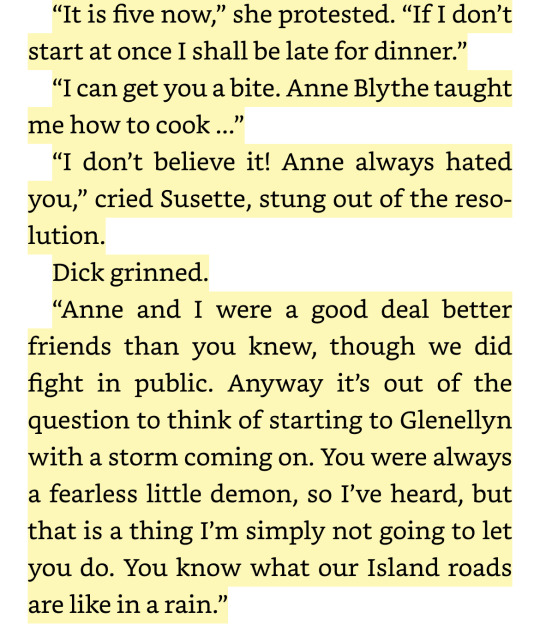
*****

*****
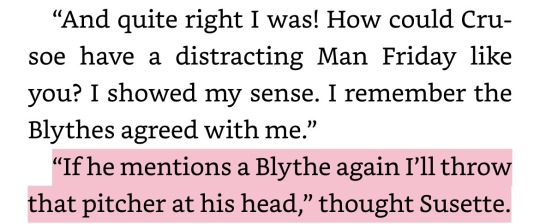
The cheap boiled-down version of this exchange, for those who haven’t ‘the Road to Yesterday’ is basically: Susette is having strange feelings during this interaction with ‘Dick’, she’s attracted to him, declaring to herself that she won’t fall in love with him, and is clearly irritated with the near constant Anne Blythe (especially)/Blythe references. Though she herself was very fond of Jem Blythe Jr. herself, during their childhood, ‘Dick’ mentioning Anne Blythe so fondly is increasingly Not Cute to Susette. Meanwhile, ‘Dick’ is enjoying this kind of teasing, and is lowkey successful at getting a rise out of Susette, not matter how determined she is to look unaffected.
But here’s the kicker... when ‘Dick’ finally leaves off mentioning Anne Blythe, guess what topic he moves on to? 🥁
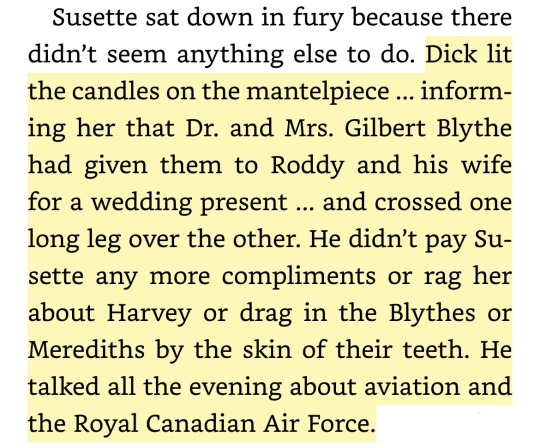
The Royal Canadian Air Force.
And just who do we all know that was in the Royal Canadian Air Force?
Shirley.
Only Shirley.
First, it tracks that ‘Dick,’ soon enlisting (we’re on the brink of WWII timeline-wise), and thinking himself funny, would choose to move on from Anne Blythe to instead a subtler rib… what he, as a once good pal of Anne’s, would know was Anne’s dad’s war faction. It’s also in the realm of possibilities that thinking on Anne so much drew up this correlation. I also ALSO think it’s worth mentioning that the only other time that the Canadian Air Force is mentioned in TBAQ is a very passing drop for Rilla, thinking of her son Gilbert Ford enlisting with the CAF. That’s it. Just those two times.
Additionally important to note is the overall subtext tone in TBAQ, which is Maud’s very greatest collection of double-vision, double-speak and intertextual reference works. There’s a beautiful scholarly essay on this, in relation to TBAQ particularly HERE.
This doesn’t only apply to cultural references in TBAQ. It also adds layers to Maud’s own existing Anne series. It really could be considered a companion piece, with X-Ray vision, e.g. how we got a ton of ‘missing’ insight into Anne and her children’s lives and minds, during the Rainbow Valley era, in Part 1 of TBAQ.
Part 2 of TBAQ (where we find ‘the Road to Yesterday’) asks us to apply what we already know to the new text we’re given.
So, understanding this … if we’re going off what we already know from ‘Rilla of Ingleside’…
What’s the reason we have the Canadian Air Force mentioned in the same story that we learn of the existence of Anne Blythe? The connection?
It’s Shirley. 🥹
A weaker argument that I’ll only mention in mild passing, because it is very weak in terms of convincing evidence, is that the text unambiguously tells is that Anne Blythe has taught ‘Dick’ from Susan’s famous recipes. Susan is another Shirley tie. It’s there to be stated. BUT. I do admit that I think Susan would’ve taught every willing Blythe grandchild with the same zeal, maybe some partiality given to the Little Brown Boy’s kid(s).
BUT, for me?
I’m properly convinced here.
Shirley was a dad, ya’ll.
#long and messy post#wrote this out in twenty minutes and i’m certain it’s utterly infested with grammatical errors and typos so i already beg your forgiveness#IF ANYONE would like to take up a counter-argument i am fully sat#shirley blythe#meta#lucy maud montgomery#the blythes are quoted
79 notes
·
View notes
Text







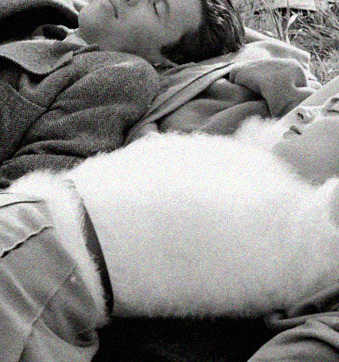

book ships: walter blythe & una meredith
O wind of dream, blow still,
For I would have it stay
That ghostly pressure sweet and chill,
That kiss of yesterday.
- WALTER BLYTHE
“He kissed Una goodbye before he went away.”
"But this was written before that, so it must have been a dream kiss."
- THE BLYTHES ARE QUOTED
#hello darkness my old friend#i hope everyone has enjoyed (tolerated) l.m. montgomery month because i had a TIME#thanks canada 🩷#anne of green gables#rilla of ingleside#the blythes are quoted#l.m. montgomery#bookedit#*
57 notes
·
View notes
Text
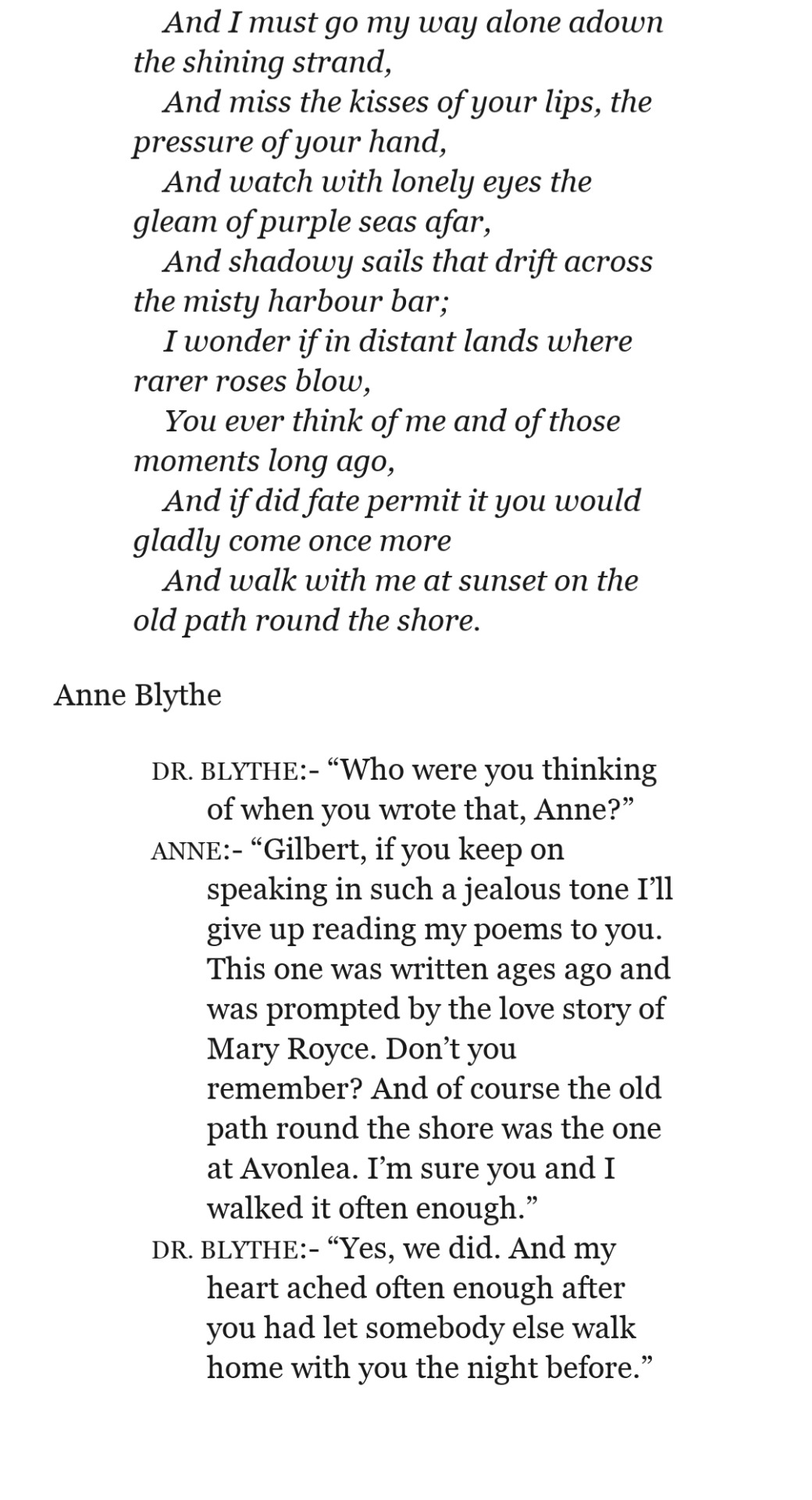
Married for decades Gilbert Blythe, STILL sour towards Roy Gardner/other Threats
#gilbert blythe#anne shirley#anne x gilbert#the blythes are quoted#blatantly jealous lol it's hilarious
163 notes
·
View notes
Text
“Irritated, he demands you explain to him
‘WHY ARE YOU SO AFRAID OF EVERYTHING?’
and suddenly it strikes you
what a privilege it must be to be annoyed instead of afraid.”
-Blythe Baird
497 notes
·
View notes
Text



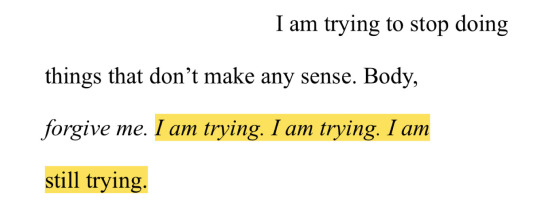
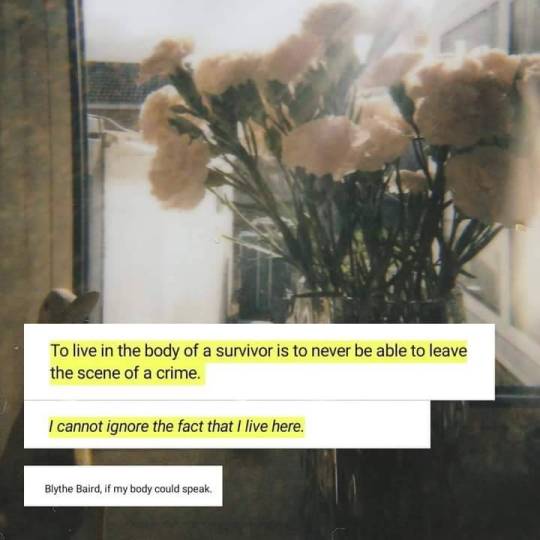


And how do you run away from what never goes away??
#dark acadamia aesthetic#dark acadamia quotes#dark acamedia#tumbler#poetry#franz kafka#artists on tumblr#beautiful quote#classic literature#blythe baird#if my body could speak#spilled writing#spilled ink#spilled love#poetry spilled ink#dark art#dark fantasy#dark web#web weaving#aesthitics#darkwave#books and novels#books and quotes#books & libraries#classic#literaure#tw ed not sheeran#language blr#book blr#translation
3K notes
·
View notes
